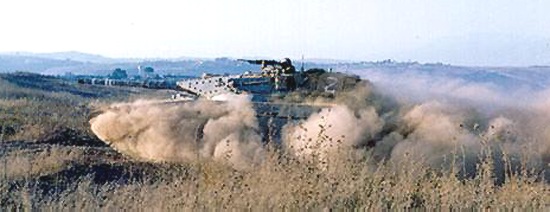MUNUC XI Security Council Crisis

Merkava Mk3 MBT on patrol in Lebanon
This crisis was run from 0200 CST Feb 7 1999 to ~0915 CST 7 Feb 1999 at
the Palmer House Hilton, Chicago, IL, by the delegates and staff of
MUNUC XI.
Credits
- Crisis design: Dan Hibshoosh, Paul Gettings, Ken Cho (with help from
many, many others)
- Final write-up: Paul Gettings, Noam Freedman
- Maps and graphics: Noam Freedman, Rand McNally
- Run by: Paul Gettings, Dan Hibshoosh, Noam Freedman, and many others
of the Information Services staff.
- Explosive damage computation: Paul Gettings using the Nuclear
Weapons Faq and High Explosives newsgroup (energy equivalent of TNT)
This crisis is almost entirely on this web site, excluding the
images used for overhead maps, and the last 2 news updates regarding Egypt
(they were never written due to lack of time).
Basic Concept
This crisis takes place in Lebanon, between Israel and Syria. It
begins with an escalation of Hezbollah and Israeli military attacks,
and ends with the possibility of full war between Israel and Syria.
Such a war could easily spread and engulf the Middle East.
This crisis had a unique twist on previous crises: the delegates were
woken up for an event that was not the actual beginning of the "real"
crisis. The delegates were woken up for the destruction of a refugee
camp and some UN peacekeepers. While they were awake, the situation
shifted from dealing with dead peacekeepers to preventing war. This
shift was rather sudden (the 0615 HGM to the U.S.), and possibly
subtle. The delegates were taken totally by surprise when they
heardabout the movement of Syrian troops. :)
Outline
The outline of the crisis is here.
Changes to Crisis during the Run
There were no major changes to it when the crisis was
run. However, due to some timing problems - the delegates didn't start
until 0230 - several news releases were done at once to get the crisis
back on the published schedule. By 0430, the crisis was on schedule.
One additional speaker was added during the run: a report on the
effects of the Hezbollah bomb. This speaker is completely optional.
The last 2 news updates regarding Egypt were dropped during the run, as
they were not necessary for continuing escalation or restoration of
debate. Moreover, beyond the published timeline, there were no more
interventions by Information staff beyond answering HGMs. If the SC
had stalled, additional escalation in the form of minor
Israel-Syria skirmishes would have been easily written as needed.
The most vulnerable point of this crisis is the necessity of the U.S.
sharing the 0615 HGM information to shift debate away from peacekeepers
to the brewing war. This was accomplished during the run by a short
talk with the U.S. delegate by an AC of the SC staff. With good, vocal
U.S. delegates, that shouldn't have been necessary.
MUNUC XI Solution
The delegates of MUNUC XI solved the crisis by passing a resolution
that had the following key components (+ boiler plate):
- A section of operative clauses dealing with the UNIFIL
peacekeepers; specifically using them to patrol the Israel/Lebanon
border.
- A section that tried to implement a long-term solution; talks
between Israel, Syria, Lebanon, U.S., etc.
- A section that called for immediate cessation of current
hostilities and withdrawl to "status quo" before the crisis
- A section that reiterated the main point of resolution 425 (1978)
that called for complete Israeli withdrawl from Lebanon in exchange for
concrete assurance of security of northern Israel.
- A section that imposed penalties for escalating to full war:
possible revokation of U.N. voting rights & blockade of all
communications and trade with involved parties.
Explosive Damage Computation
The explosion computation was done by using the power-law scaling relation
for nuclear device blast damage from the "Nuclear Weapons FAQ". The
yield of the device is computed in equivalent TNT tonnage by comparing
the energy released vs. TNT (4520 kJ/kg). This gives radii of pressure
fronts in km. For a 4 ton TNT yield, the 1 psi radius is ~355 meters
(0.355 km). These radii were then drawn on a map of Tel Aviv to
determine blast effects. Casualties were guessed.
A short C program to compute the radii of various pressure levels is
available here. It should compile with any ANSI
C compiler. Note that the computation is a simple power-law, and the
powers are taken directly from the Nuclear Weapons FAQ.
Random Trivia
- TNT liberates 4520 kJ/kg of energy when detonated.
- This entire crisis was designed on Thursday and Friday, written
Friday and Saturday, in HTML, on a computer in Utah, from Chicago.
- Total man-hours: estimated at <66, most likely ~40-50. This
includes handling the normal running of the Security Council and the
creation of "red herring" updates (Kosovo, Korea, Spratlys, Cyprus,
Iraq). At no point did the number of people working exceed 3.
- Wall map purchased at Rand McNally, all other images found on the
web: UNIFIL home page for UNIFIL deployment map (January 1999), others
for Lebanon. Tel Aviv bomb map created by enlarging wall map,
scanning, and using MS Photo Editor.
- Typical # of people in Crisis Room during the run: 3-4; Paul
Gettings, Noam Freedman, Dan Hibshoosh, and Aaron ?? (the news
anchorman).
- AV Equipment used: 2 video cameras, 1 mike-speaker rig for
listening to committee, 1 A/V switcher, and 3 monitors for setting up
shots before switching to TV in SC room.

